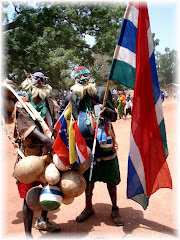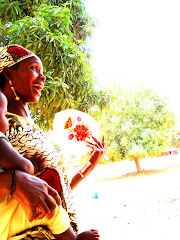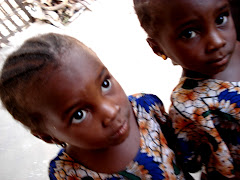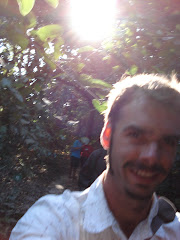My mom & dad wondered if I was just making-up these weird stories so they came to The Gambia to have a see for themselves.

A day after they flew into Senegal, we got the Car from Dakar. We arrived at the crazy-busy-for-pre-Tobaski-travel carpark early in the morning and began the eight hour trek to The Gambia.

The road was long, bumpy, and dusty. The car was cramped and uncomfortable. Mom & Dad were amazed by the travel conditions.

Once in the Gambia, we had to board the overloaded Kanalai Ferry across the River Gambia from Barra to Banjul.

President Kennedy had three goals in mind when he organized Peace Corps in 1960. Besides helping the people of interested countries with technical assistance, Peace Corps places a strong emphasis upon the cultural exchange.

Many people come to The Gambia every year as tourists from Europe and Asia. Living up-country, I normally don't get much exposure to that experience. With my parents here, I spent two weeks living as a tourist in the Kotu Beach area. Typically-tourist activities offer a very different version of The Gambia apart from the one I have known.

My parents had a nice room at the Bakotu Hotel. It was right on the Atlantic Ocean near bird-watching preserves, restaurants, and a craft market. Here they became adept at deflecting the weird advances of Bumsters on the beach and over-zealous, hard-sell vendors in the market.

If I lived in the Kombos rather than up-country, I'd be very interested in working within the tourism industry. It is the vehicle by which most foreigners experience The Gambia and can offer a means of income for people in a variety of occupations.

West African folk art, clothing, and hand-carved wood objects can be found in The Gambia's markets.

Most vendors enjoy a spirited exchange when bargaining for crafts. If you try, sometimes you can get something for less than half of the originally-stated price. I sometimes felt bad quibbling over what would amount to less than $2U.S. Othertimes, I got caught-up in the thrill of haggling.


Some craftspeople go to the trouble to describe the process of making their art. My parents enjoyed learning about batik printing from this artist in Bakau.

One vendor offered my father "any ting in da shop" in exchange for his sandals. He might have gone for it if I hadn't reminded him that he'd have trouble getting home walking with drums or masks for shoes.

After a few days rest on the beach, we decided to travel up-country to my village in Foni Jarrol. My folks wanted to bring a little "silafonda" for my village so we went to a livestock yard and Dad helped me choose a healthy ram.

We decided to take a gele-gele from Brikama to Foni Jarrol. The ride usually takes about three hours.

Waiting for a ride might also take three hours.

We finally caught a ride in the hot pink gele-gele that goes direct to Kampasa. We rode inside and the ram took a seat on the roof.

The ride was dusty and bumpy. This would be a continuing theme during my parents' visit.

We arrived in my village in the afternoon and the celebration began as soon as we stepped out of the vehicle. Gambians are great at welcoming people. All the members from my community came out to greet us and there was dancing and drumming.


My host-brother made a welcome note from some bones that I was saving to pound into bonemeal.

My mom and dad were the focus of attention for the entire time we were there.


My mom taught women about cross-stitch.
While my dad taught children about digital photography.
The accomodations at my house were a little rougher than parents were expecting.
They had trouble sleeping because of all the sounds that a village makes through the night. Donkeys braying, music playing, babies crying. Women start pounding millet and rice early in the morning to beat the heat of the sun.

But if you can't beat 'em, might as well join 'em.
To really show my folks what the village experience is like, I got them involved helping-out with chores like fetching water.


We enjoyed seeing traditional practices and lifestyles in the village. We went into a few houses and continued to meet everyone.
Adama showed us how peanut-butter is made and my mom got a sample.

Molaamin taught us how to seperate peanuts from the shells after the threshing is finished.

We explored some of the gardens and banana patches.

Becca came down from her village to join in the festivities. She showed my dad how to dig yams.
Meanwhile, my mom continued with her cross-stitch demonstration.

Eventually it was time to kill the ram that we had brought.

As the "joom gaale" head of the compound and elder, Baa Cheike would attend to the sacrifice.

And Baa's namesake and youngest grandson would look-on in fascination.
Landing and I worked on the buthering of the ram.

My dad continued to entertain the children with his antics.
Alieu helped prepare the intestines which became a highly prized component of the food bowl.
As did the head.
Landing divided the meat and we took some to every compound in the village.
My mom and dad really enjoyed the Gambian food bowl.
Eventually we had to leave and continue our safari further up-country. My village tried to get us to stay longer. They thought we should linger for at least a month. But we had hired a car to come pick us up and take us to Janjanbureh Island and so we had to leave.
But we didn't make it too far before the troubles of the road provided for an unexpected stop.
Back in America, my father is an analyst for a major petroleum company. Even with all he sees Stateside, I think he was surprised that in The Gambia the gas pumps are hand-cranked.
We stopped at the Wassu Stone Circles near Kuntaur. These stones were placed here and in other locations nearby during the Iron Age from AD400 to AD1000 and are thought to have had spiritual significance for the Animist agriculturalists.
We stayed at a small guesthouse called Baobalon Camp on the Island.
And while it was a step-up from the conditions that we experienced in village, I don't see what is all the fuss about indoor plumbing.
We hired a tour guide to help us navigate the roads and streams of The Gambia's hinterland. He was a Fula who called himself Dan D. Man. He works for Gambia Tours which is a Gambian-owned operation promoted by the National Tourism Authority.
Dan D. Man organized a boat trip from Kuntaur on the River Gambia.
While I was too slow with my camera to prove it to you Dear Reader, please believe me when I tell you that the river was teeming with wildlife. On the three hour trip, we saw hippos, a crocodile, a python, and various exotic birds.
We floated alongside the Baboon Islands which are home to 73 chimps as part of the Chimpanzee Rehabilitation Project. The list of mammals on the islands includes baboons, red colobus monkeys, aardvark, warthogs, bushbucks, and duikers.
The journey was long and Dan D. Man had to pay many bribes to get us through the numerous immigration, military, and police checkpoints.
Dan D. Man also helped us negotiate the carpark and ferry terminal when we arrived back in Barra.

Once we settled back into the hotel at Kotu, we continued to explore the tourist shops and restaurants along the shore.

There is always something amusing to stop and see.
To really get that African Safari feel, my dad tracked wild game back in Kotu.
We went to a cultural museum in Bakau where we learned about history, spirituality, and politics.


We visited the Katchikally Sacred Crocodile Pool. The pool is said to bring good luck to visitors and has been a traditional healing site for generations.

The crocodiles who live here are ravenous and not to be reckoned-with.

My dad has never been known to wear jewelry. This crocodile tooth however will probably never leave his neck.

Don't let him fool you if he tries to tell you about his wild crocodile wrestling trip to the tropical environs of deepest, darkest Africa. He bought it from a little old woman half his size for $6.

And that pretty much wraps-up my mom & dad's Christmas safari. They brought me gifts of toothpaste, jerky, and a new headlamp. I also kept one of their backpacks while they took my hiking boots and Nikon camera back to the USA.

Having no interest in making the overland trip back to Dakar for their flight to Atlanta, they bought a ticket to fly from Banjul on Senegal Air.

I cannot express how happy I am that my parents came to visit me. Peace Corps offers so many opportunities for cultural exchange. While my parents are not Volunteers, they too have gotten to experience much of what a place like The Gambia has to offer. The journey was exhausting at times and relaxing at others. Somethings were rough while others enormously pleasurable. I learned a lot about this country and its culture while my parents were here and I am sure that they will have memories that will remain vivid for years. I think that now they have experienced first-hand that The Gambia is a diverse and unpredictable place. When I asked them what was their favorite part of the trip they both agreed that getting to know my host family and friends in Foni Jarrol was the highlight.




























 But if you can't beat 'em, might as well join 'em.
But if you can't beat 'em, might as well join 'em.







 Eventually it was time to kill the ram that we had brought.
Eventually it was time to kill the ram that we had brought. As the "joom gaale" head of the compound and elder, Baa Cheike would attend to the sacrifice.
As the "joom gaale" head of the compound and elder, Baa Cheike would attend to the sacrifice. And Baa's namesake and youngest grandson would look-on in fascination.
And Baa's namesake and youngest grandson would look-on in fascination.









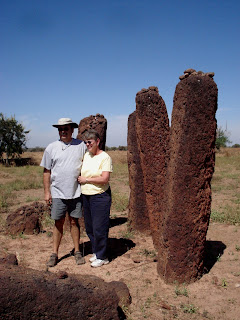
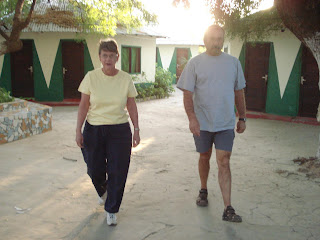










 My dad has never been known to wear jewelry. This crocodile tooth however will probably never leave his neck.
My dad has never been known to wear jewelry. This crocodile tooth however will probably never leave his neck.






















